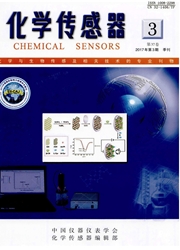

 中文摘要:
中文摘要:
采用改进的Hummers法制备了氧化石墨烯(G01.用微波辅助丝素还原法制备了丝素还原石墨烯(SF—GR),并用红外(FT—IR)、紫外(UV—vis)和透射电镜(TEM)对SF—GR进行了表征。然后以丝素同时原位还原的石墨烯一纳米金复合水凝胶包埋酪氨酸酶fTyr)制备了新型的有机相酶电极(SF—GR—NanoAu—Tyr/GCE),在纯氯仿中对呋喃丹进行了检测。结果表明,在有机相中,丝素水凝胶能较好的保持酪氨酸酶的生物活性,GR和NanoAu促进了电子在电极界面上以及水凝胶内部的电子传递,提高了酶电极的灵敏性。在没有另外添加水或者缓冲液的情况下,酪氨酸酶的抑制率与浓度范围为1.0×10^-8~1.0×10^-12mol/L的呋喃丹呈线性关系,检测限为8.0×10^-13mol/L。该有机相酶电极制备简单,检测快速,灵敏度高,适合于有机溶剂中微量农药的定量检测。
 英文摘要:
英文摘要:
Graphene oxide was prepared by the method of modified Hummers. Silk-reduced-graphene (SF-GR) was prepared using microwave-assisted silk fibroin reduction synthesis method. TEM, FT-IR and UV-vis were uti- lized to characterize SF-GR. Then, a novel highly sensitive enzymatic inhibition organic phase enzyme electrode (OPEE) was fabricated by enwrapping tyrosinase in graphene-gold nanoparticles-silk fibroin hydrogel. The SF hy- drogel provided a necessary amount of water and a biocompatible microenvironment around the enzyme molecule to stabilize its biological activity and effectively prevented its inactivation by inhibitors such as pesticides. Under op- timized conditions, the inhibition percentage of carhofuran was proportional to its concentration in the range of 1.0×10^-8to 1.0×10^-12mol/L with a detection limit of 8.0×10^-13 mol/L. Thus, the highly sensitive OPEE is a promis- ing new tool for pesticide analysis in organic solvents.
 同期刊论文项目
同期刊论文项目
 同项目期刊论文
同项目期刊论文
 Controlled chitosan coated Prussian blue nanoparticles with the mixture of graphene nanosheets and c
Controlled chitosan coated Prussian blue nanoparticles with the mixture of graphene nanosheets and c A novel photoelectrochemical sensor based on PPIX-functionalized WO3-rGO nanohybrid-decorated ITO el
A novel photoelectrochemical sensor based on PPIX-functionalized WO3-rGO nanohybrid-decorated ITO el beta-cyclodextrin-ferrocene host-guest complex multifunctional labeling triple amplification strateg
beta-cyclodextrin-ferrocene host-guest complex multifunctional labeling triple amplification strateg Electrochemical immunosensor with graphene quantum dots and apoferritin-encapsulated Cu nanoparticle
Electrochemical immunosensor with graphene quantum dots and apoferritin-encapsulated Cu nanoparticle DNA-enhanced peroxidase-like activity of layered double hydroxide nanosheets and applications in H2O
DNA-enhanced peroxidase-like activity of layered double hydroxide nanosheets and applications in H2O Electrochemical determination of NADH using a glassy carbon electrode modified with Fe3O4 nanopartic
Electrochemical determination of NADH using a glassy carbon electrode modified with Fe3O4 nanopartic Multi-walled carbon nanotube-chitosan/poly(amidoamine)/DNA nanocomposite modified gold electrode for
Multi-walled carbon nanotube-chitosan/poly(amidoamine)/DNA nanocomposite modified gold electrode for Direct electrochemistry of sarcosine oxidase on graphene, chitosan and silver nanoparticles modified
Direct electrochemistry of sarcosine oxidase on graphene, chitosan and silver nanoparticles modified Gold nanoparticles as colorimetric sensor: A case study on E. coli O157:H7 as a model for Gram-negat
Gold nanoparticles as colorimetric sensor: A case study on E. coli O157:H7 as a model for Gram-negat Multifunctional Fe3O4 core/Ni-Al layered double hydroxides shell nanospheres as labels for ultrasens
Multifunctional Fe3O4 core/Ni-Al layered double hydroxides shell nanospheres as labels for ultrasens Nonenzymatic amperometric organic peroxide sensor based on nano-cobalt phthalocyanine loaded functio
Nonenzymatic amperometric organic peroxide sensor based on nano-cobalt phthalocyanine loaded functio Acetylcholinesterase biosensor based on 3-carboxyphenylboronic acid/reduced graphene oxide-gold nano
Acetylcholinesterase biosensor based on 3-carboxyphenylboronic acid/reduced graphene oxide-gold nano Electro-oxidation nitrite based on copper calcined layered double hydroxide and gold nanoparticles m
Electro-oxidation nitrite based on copper calcined layered double hydroxide and gold nanoparticles m Drinking water disinfection by hemin-modified graphite felt and electrogenerated reactive oxygen spe
Drinking water disinfection by hemin-modified graphite felt and electrogenerated reactive oxygen spe Effective photocatalytic disinfection of E. coli and S. aureus using polythiophene/MnO2 nanocomposit
Effective photocatalytic disinfection of E. coli and S. aureus using polythiophene/MnO2 nanocomposit A novel hydrogen peroxide biosensor based on the specific binding of horseradish peroxidase with pol
A novel hydrogen peroxide biosensor based on the specific binding of horseradish peroxidase with pol Electrochemical detection of avian influenza virus H5N1 gene sequence using a DNA aptamer immobilize
Electrochemical detection of avian influenza virus H5N1 gene sequence using a DNA aptamer immobilize Electrochemical detection of DNA damage induced by acrylamide and its metabolite at the graphene-ion
Electrochemical detection of DNA damage induced by acrylamide and its metabolite at the graphene-ion Electrochemical oxidation behavior of guanosine-5 '-monophosphate on a glassy carbon electrode modif
Electrochemical oxidation behavior of guanosine-5 '-monophosphate on a glassy carbon electrode modif Electrochemical determination of microRNA-21 based on graphene, LNA integrated molecular beacon, AuN
Electrochemical determination of microRNA-21 based on graphene, LNA integrated molecular beacon, AuN Ag/AgBr/CoNiNO3 Layered Double Hydroxide Nanocomposites with Highly Adsorptive and Photocatalytic Pr
Ag/AgBr/CoNiNO3 Layered Double Hydroxide Nanocomposites with Highly Adsorptive and Photocatalytic Pr Ag nanoparticles and vancomycin comodified layered double hydroxides for simultaneous capture and di
Ag nanoparticles and vancomycin comodified layered double hydroxides for simultaneous capture and di Electrochemical behaviour of Sudan I at Fe3O4 nanoparticles modified glassy carbon electrode and its
Electrochemical behaviour of Sudan I at Fe3O4 nanoparticles modified glassy carbon electrode and its Electrochemical biosensing method for the detection of DNA methylation and assay of the methyltransf
Electrochemical biosensing method for the detection of DNA methylation and assay of the methyltransf Ultrasensitive photoelectrochemical immunoassay o f indole-3-acetic acid based on the MPA modified C
Ultrasensitive photoelectrochemical immunoassay o f indole-3-acetic acid based on the MPA modified C 2D ultrathin nanosheets of Co-Al layered double hydroxides prepared in L-asparagine solution: enhanc
2D ultrathin nanosheets of Co-Al layered double hydroxides prepared in L-asparagine solution: enhanc Electrochemical behavior of catechol, resorcinol and hydroquinone at graphene-chitosan composite fil
Electrochemical behavior of catechol, resorcinol and hydroquinone at graphene-chitosan composite fil Electrochemical immunoassay for subgroup J of avian leukosis viruses using a glassy carbon electrode
Electrochemical immunoassay for subgroup J of avian leukosis viruses using a glassy carbon electrode Selective determination of melamine in milk samples using 3-mercapto-1-propanesulfonate-modified gol
Selective determination of melamine in milk samples using 3-mercapto-1-propanesulfonate-modified gol Flower-like Bi2Se3 nanostructures: Synthesis and their application for the direct electrochemistry o
Flower-like Bi2Se3 nanostructures: Synthesis and their application for the direct electrochemistry o Fabrication of DNA electrochemical biosensor based on gold nanoparticles, locked nucleic acid modifi
Fabrication of DNA electrochemical biosensor based on gold nanoparticles, locked nucleic acid modifi 期刊信息
期刊信息
